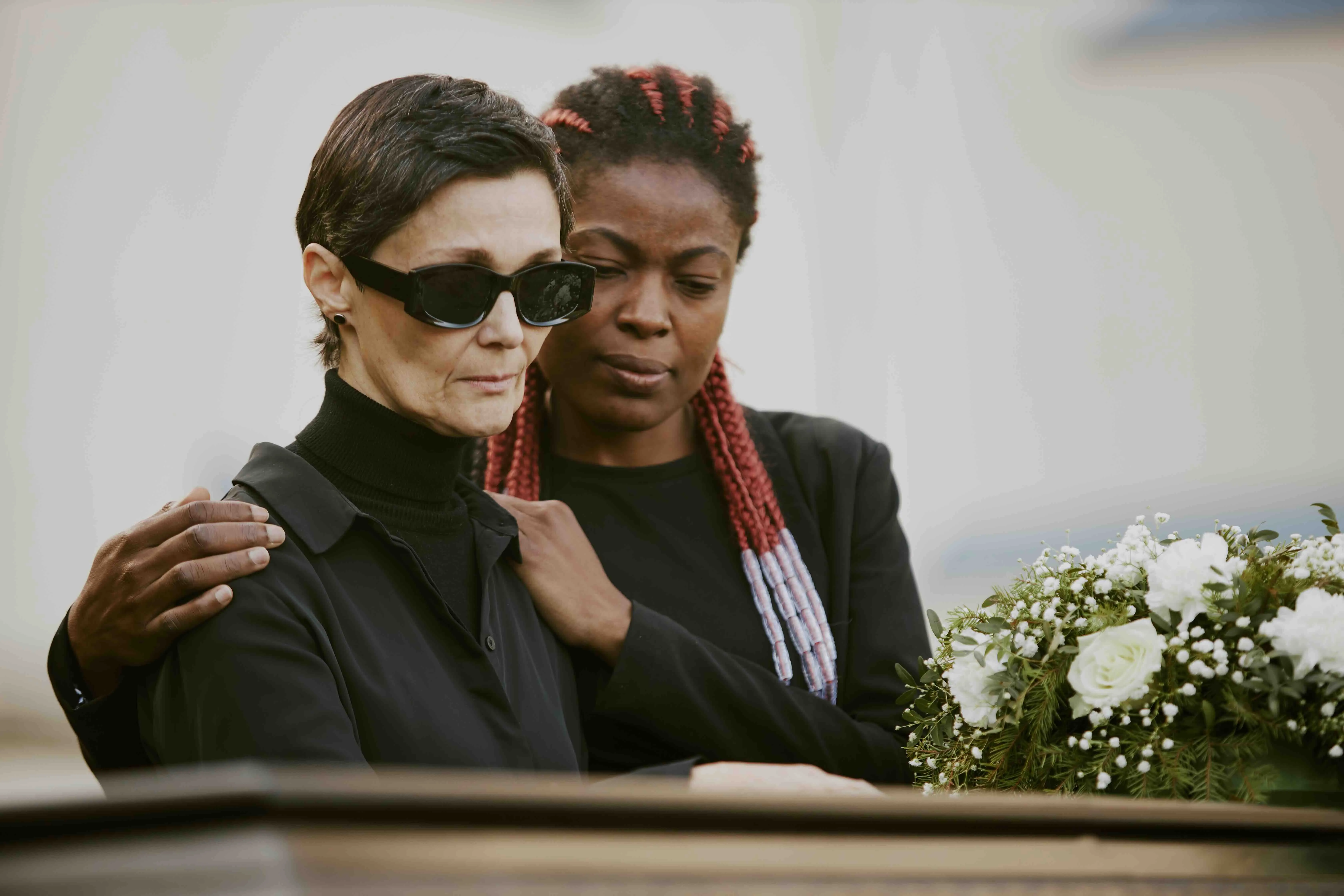Eulogy: Examples, Structure, and How to Write One

There’s a quiet kind of pressure that comes with writing a eulogy, the need to honor, to capture, to do justice to a life. It’s not easy, especially when your own heart is still catching up to the loss. But at its core, a eulogy is an offering. A way to speak what mattered most.
If you’re sitting down after the death of a loved one, wondering what to say and how to say it, we’re here for you. This guide will walk you through what a eulogy is, how to craft one with heart, and real eulogy examples that might help you begin.
What is a eulogy?
A eulogy is a tribute speech, usually given during a funeral or memorial, that reflects on the life and character of the person who has passed. It's an opportunity to honor them through stories, personality traits, and shared memories.
Typically, eulogies are delivered by close family members, friends, or even colleagues, depending on the relationship. There's no one-size-fits-all rule; it’s about who feels called to speak and can do so with care.
Funeral Speech vs. Eulogy: Is there a difference?
A funeral speech and a eulogy are often used interchangeably, but there can be subtle differences. A funeral speech might include logistical elements like thanking attendees or reading spiritual texts, while a eulogy focuses primarily on personal stories and characteristics. The tone of both should be respectful and authentic, but a eulogy often leans more into emotion and storytelling. To learn more about funeral planning, read our blog “How to Plan a Funeral: Complete Guide, Costs & Planning Checklist”.
How to Write a Eulogy
Writing a eulogy is a deeply personal task. It's less about formal writing and more about conveying the person’s impact. Begin with the mindset that you’re sharing a piece of someone’s legacy, not performing or trying to sum up a life in five minutes. It can be tempting to focus on your own grief, but the most meaningful eulogies are those that shine a light on the life lived and the stories shared.
Step 1: Gather Thoughts and Memories
Decide on a time when you can disconnect from your daily life and reflect on your person. Go to a quiet space, bring a notebook, and take some deep breaths.
Start by jotting down stories, phrases, or qualities that come to mind about your loved one. Talk to other people who knew the person; sometimes, a small detail from someone else can spark the perfect memory. Think through different life stages: childhood, career, family life, and hobbies. What were their routines, quirks, or passions?
Step 2: Choose 3 Traits That Defined Them
One path to writing a heartfelt eulogy is the three-trait method. Focus on three traits that captured who they were. Maybe they were endlessly generous, deeply curious, or had a dry sense of humor. Narrowing down to three helps the eulogy stay focused and makes it easier to build a few stories around core themes.
Step 3: Match Each Trait with a Story
Now, pair each trait with a personal story. These don’t need to be long or dramatic. Perhaps they gave you an unforgettable piece of advice while you were walking through your neighborhood. Maybe you two went to a concert together that changed your life.
What do these stories say about their character? How can you show the audience what type of person they were? Be honest. You can include humor and vulnerability. Grief doesn’t erase complexity, and people connect with authenticity.
Step 4: Write a Beginning, Middle, and End
Finally, it’s time to write. This is only the first draft, so it doesn't have to be perfect; just get your ideas on paper. Follow this structure for your eulogy so it flows with clarity:
Beginning:
- Introduce yourself and your connection to the person.
- Share a brief background of the deceased.
- Talk about some of their best qualities and values. Start light, as it will be a very emotional day.
Middle:
- Share your stories and the traits you chose, weaving in any quotes, memories, or relevant stories.
- Explain what truly mattered to them: loved ones, a favorite pastime, or even a cherished pet. If they had a partner or children, share a few words about those relationships. You may even address them directly during your speech.
- Reflect on the milestones that defined their life, from major achievements to meaningful life chapters.
End:
- Wrap up your eulogy with a lasting impression; this might be a phrase your loved one often said, or a message that reflects the central theme of your tribute.
- Consider addressing your loved one directly, offering a simple expression of love or gratitude in your own words.
- You can also thank those gathered for their support and presence, and acknowledge how much the person being honored valued the people around them.
- Ending with a brief quote, a meaningful poem, or a cherished line from a song can provide a gentle and heartfelt close to your words.
Step 5: Have A Trusted Person Review
It is best to have someone you love and trust review it for feedback. As with any speech or piece of writing, a second set of eyes will always be beneficial.
Step 6: Edit and Practice Reading Aloud
After you write, step away. Come back to it with fresh eyes. Practice reading it out loud, not for perfection, but to make sure it flows.
Set a timer while you read, aiming for a length of 5–10 minutes. Keep a printed copy on hand in case emotions take over and you need a pause. On the day of, remember to take deep breaths and take your time speaking. Dress appropriately, get lots of sleep the night before, and drink water.
Eulogy Examples
Examining real eulogy examples can help you understand how different tones and approaches work. Spending some time reading memorable eulogies from public figures is a good start to finding inspiration. For example:
- Maya Angelou’s Eulogy for Coretta Scott King
- Steve Irwin’s Eulogy by Bindi Irwin
- Oprah Winfrey's Eulogy for Rosa Parks
These moving tributes show how stories, values, and personal reflections can honor someone’s legacy in powerful ways. But not every eulogy needs to be grand or public to be meaningful. The most touching ones often come from personal moments and quiet memories.
Here are a couple of short examples to inspire your own writing:
Short Sample Eulogy for a Mother or Father
“My mom was the type of person who made everyone feel like family. She taught me how to listen, how to laugh even when things were hard, and how to always keep a pack of tissues in your bag, just in case. Her love was steady, and her lessons will stay with me forever. She wasn’t loud, but she led with quiet strength. She showed up: for school plays, bad days, and late-night talks, and made sure we always knew we were loved. Her kind of presence doesn’t disappear. It stays in the way we care for others and in the traditions we carry on.”
Short Sample Eulogy for a Friend
“Alex had a way of showing up exactly when you needed him. Whether it was a phone call after a hard day or a ridiculous meme to make you laugh, he knew how to make people feel seen. I’ll miss his calm presence and the way he never let a moment pass without adding a little joy. What I admired most was his consistency: he was always there, always ready to listen, and always down to go get a burger at our favorite spot. We bonded over late-night walks and shared playlists, and I still catch myself reaching for my phone to send him a song. He gave his friends the rare gift of feeling completely understood, without ever needing to say much.”
How long should a eulogy be?
Most eulogies fall between 5 to 10 minutes, which translates to about 500–1000 words. That’s usually enough time to share a few meaningful stories without overwhelming listeners. The length can shift based on cultural traditions, setting, or how many others are speaking. Time yourself when reading aloud, and be prepared to adjust.
The Role of Connection in Honoring a Life
Writing a eulogy is about connection and honoring your special person. It’s a bridge between memory and meaning, giving shape to stories that deserve to be carried forward.
At Caily, we believe in honoring that connection. Our platform helps families stay organized, share memories, and preserve moments that matter. Whether you're saving a eulogy in the Vault, planning funeral details, or supporting others through loss, we're here to help you stay connected, even after goodbye.

Frequently Asked Questions About Writing a Eulogy
What is a eulogy?
A eulogy is a speech given at a funeral or memorial service to honor the life of someone who has passed away. It usually includes personal stories, memories, and reflections.
How to write a eulogy?
Start by gathering stories, choose a few defining traits, connect each to a meaningful story, and structure the speech with a clear beginning, middle, and end. Focus on sincerity and connection.
How long should a eulogy be?
Aim for 5–10 minutes or about 500–1000 words. Practice reading it aloud and edit to fit the tone and format of the ceremony.
